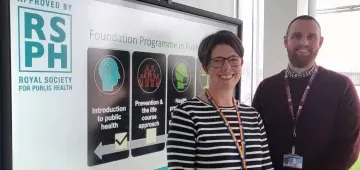
Peter Melchett, Policy Director at the Soil Association, contends that the era during which public health professionals could happily ignore what happens on farms is well and truly over.
Unhealthy diets continue to cause more disease and deaths in the UK. The NHS cost of diabetes has doubled in a decade, to 10% of the total NHS budget. Back in 2008, the Cabinet Office said that ‘children are probably the most vulnerable and at highest risk of significant future diet-related ill health’, and despite that clear recognition of the problem, childhood obesity continues to rise, especially among the poorest families. And the horror stories get worse – recently, children were said to be having hip replacements because of obesity.
So links between food and health are seldom out of the news, and taxes on sugar, salt reduction targets and voluntary bans on a few food additives, are endlessly chewed over by nutrition experts and big food manufacturers and retailers. Those same experts rarely think about how food is produced. They seem to think that food simply arrives at a large factory or retail store, and the only thing that will affect its quality, and its impact on our health, is what is done when it is processed, packaged and sold.
This leads to a mismatch between public attitudes and expert opinion about the danger of pesticides in our food. Avoiding pesticides is the main reason that people buy organic food, but expert opinion has tended to ignore risks from sprays left in food. Health professionals seem reluctant to confront a basic aspect of intensive food production. Similar criticisms are made of nature conservation bodies in a recent paper, which suggested that since DDT was banned, environmentalists have taken their eye off the pesticide ball. This may explain why we see continuing, steep and extraordinarily depressing declines in farmland wildlife in countries like the UK.
This reluctance to confront pesticide use has been compounded by an unchallenged claim from the pesticide industry that pesticide use in the UK has halved in recent years. It has halved if measured by weight, but that tells you nothing about the number and toxicity of the chemicals applied to growing crops.
At a recent Royal Society of Medicine conference on the health impact of low levels of pesticides in food, Professor Carlo Liefert presented data which showed the number of active ingredients applied to three common UK crops has in fact increased dramatically. The average number of active ingredients applied has increased by a staggering 5.8 to 18 times – for wheat x12, potatoes x5.8 and onions and leeks x18.
The conference also heard scientists describe new evidence which suggests very low doses of pesticides, well below the official safety levels (Maximum Residue Levels - MRLs), can have an adverse impact. Very low doses of pesticides have been shown to have an effect at the genetic level; new research found that taking very low levels of pesticides, in succession, can make the second pesticide have negative impacts even though present below the MRL.
Mixtures of pesticides, found in food, have no safety levels set at all. MRLs are set for individual active ingredients, but the huge number of combinations in food, and taken into human body from a range of different sources, means that no safety testing is possible. This new science, coupled with evidence that the number of active toxic chemicals applied to crops is increasing dramatically, should mean the experts at long last starting to catch up with public concerns about pesticides.
One area where the experts have managed to make the breakthrough back to the farm in terms of food quality and human health is overuse of antibiotics. The Soil Association has been campaigning for 20 years to draw attention to the overuse of antibiotics in farming, and the danger increasing antibiotic resistance (caused by overuse in farming as well as in human medicine) poses to human health.
Only in the last few years has the farming case been accepted, although the danger of antibiotic overuse leading to resistance has been recognised since their creation. Now many countries are taking rapid steps to reduce antibiotic use in farming. Practice varies – high levels of antibiotics are still used on chickens and pigs in the USA – a far more powerful reason than chlorine washed chickens for us not allowing the import of animal products in any post-Brexit trade deal that we do with America.
A second conference looking at links between farming, food and health is being held at the Royal Society of Medicine on 8 February next year. This conference will look at the current state of play of antibiotic use in agriculture. Significant cuts in antibiotic use in UK farming have been made over the last couple of years, particularly with poultry, and to some extent with pigs. This is due to pressure from government and health bodies, but the cuts made so far go nowhere near the levels achieved by organic farming.
The conference will hear about the cuts in antibiotic use that would be possible if there was a change in systems to more extensive and organic livestock farming. Of course those changes to livestock systems could also go hand-in-hand with huge reductions in pesticide use.
The Royal Society of Medicine conferences hopefully signal a new era of interest in farming systems, and what is done to our food while it is being grown and reared on farms. Food grown organically, and dairy and meat products from animals reared organically, are nutritionally different, and have more beneficial nutrients in them, than non-organic food.
We do not yet know if those of us who eat an organic diet turn out, in general, to be healthier than those who do not, but early research results suggest that there might be some real health benefits. In any event, the era during which public health professionals could happily ignore what happens on farms seems to be well and truly over.



